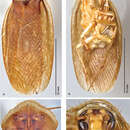Description
(
Inglês
)
fornecido por Zookeys
Male. NB: Ventral surface of holotype shellacked. Measurements. Holotype TL = 20.9 mm, GW = 9.7 mm, PW = 6.07 mm, PL = 4.27 mm, TL/GW = 2.15, PL/PW = 0.70. EW = 0.40 mm; OW = 0.40 mm. Among paratypes range of TL 16.7–23.0 mm; range of GW 7.3–10.4 mm; range of PW 5.06–6.30 mm; range of PL 3.98–4.90 mm.
Head. Two ocelli large, ovoid and protruding (0.35 × 0.25 mm); vertex medium brown, with small ridges between apices of eyes and extending onto ocellar tubercles; interocellar space concave, medium brown. Frons light brown, concave with occasional very long setae; bound on either side by ridges extending from inner apex of ocelli outwards to lateral edges of clypeus. Anterior portion of frons light brown, bulbous; clypeal suture demarcates light brown anteclypeus. See Fig. 21d.
Pronotum. Pronotum translucent waxy beige, often only along anterior margin depending on specimen with remainder of pronotum medium orange-brown; variable length orange-brown setae along anterior margin; dorsal surface of pronotum covered with short orange-brown setae; pronotal pattern “panther face” ranging from light brown through every shade of orange-brown and brown with many shades of aura, usually extensive, depending on specimen; detail ranges from clear to indiscernible. See Fig. 21c.
Body. Wing brace present. Legs and body light orange-brown; subgenital plate light orange-brown; asymmetrical with posterior edge emarginated, rounded apices. See Fig. 21b.
Forewings. Wings extended beyond abdominal apex (up to ~40% of total wing length); dark-orange brown densely blotchy; majority of specimens with medium to dark brown or orange-brown densely blotchy wings; occasional specimens light or very dark, or with uniform coloration; surface opaque and matte. See Fig. 21a.
Genitalia. Right dorsal phallomere composed of bulbous lightly sclerotized narrow hook-shaped lobe, articulated with right ventral phallomere on lateral side; central field broad, slightly sclerotized; medial margin heavily sclerotized, sinuous, with toothed edge; long posteriorly projecting spine and shorter anterior spine; anterior spine of varying sizes depending on specimen. Teeth along medial edge may be variously lengthened depending on specimen. Small central sclerite deeply concave, punctate, with medially projecting punctate lobe on ventral end. Right ventral phallomere extends from articulation into smooth lobe with prominent medially projecting spine at posteroventral corner; increasingly punctate and sclerotized anteriorly; after narrow gap, wide rounded concave shagreened arm extending beyond the depth of rest of phallomere. Folded anterior portion of left phallomere narrow, trifold, punctate, otherwise unmodified. Genital hook (missing from holotype) with moderate extension to pointed head with slight concavity on moderate hook; arm narrow and smoothly curved. See Fig. 22.
- licença
- cc-by-3.0
- direitos autorais
- Heidi Hopkins
- citação bibliográfica
- Hopkins H (2014) A revision of the genus Arenivaga (Rehn) (Blattodea, Corydiidae), with descriptions of new species and key to the males of the genus ZooKeys 384: 1–256
- autor
- Heidi Hopkins
Distribution
(
Inglês
)
fornecido por Zookeys
Arenivaga apacha is found in in the entire southeastern portion of Arizona and northwestwards from there. The appearance on the map that the distribution ends at the Mexican and New Mexican borders is without doubt a collection artifact. See Fig. 23.
- licença
- cc-by-3.0
- direitos autorais
- Heidi Hopkins
- citação bibliográfica
- Hopkins H (2014) A revision of the genus Arenivaga (Rehn) (Blattodea, Corydiidae), with descriptions of new species and key to the males of the genus ZooKeys 384: 1–256
- autor
- Heidi Hopkins

